Women in STEM
March is Women's History Month, a time to celebrate the contributions women have made to society. Sigma Xi will participate by celebrating women's contributions to science, technology, engineering, and math (STEM). We asked Sigma Xi members in STEM to share their experiences.
Abigail Amissah-Arthur
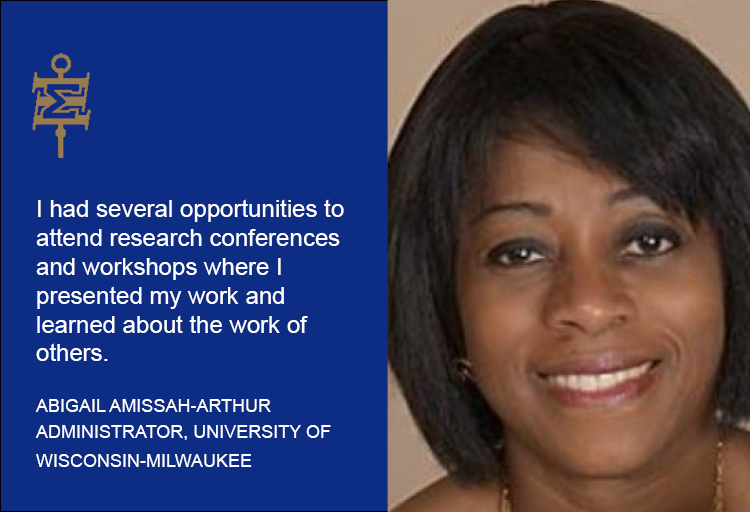
Current position
Director of the Office of Research Programs in the College of Health Sciences at the University of Wisconsin-Milwaukee
Please describe your job.
My position provides high-level support and advice on matters related to research infrastructure, research compliance, and funded & unfunded research in the College of Health Sciences. The position assumes a central role in annual planning and management of operations and services including the cultivation of research culture, building and establishment of collaborative research teams, promotion of organizational research accomplishments, and organization of research symposium and events for sharing and promotion of results of our scientific inquiries.
What are the top resources that have helped you in your career as a woman in STEM and why were they helpful?
I started my career as an environmental scientist with a focus on the impact of climatic variability, climate change on food production, and the application of climate prediction in decision making in agriculture. Over the years, I moved from a faculty and research scientist role into a full administrative role. I have been lucky to have had the opportunity earlier in my career to work with a number of famous scientists in my field. The interactions and mentoring that I received back then has been invaluable in building my own independent career. As a graduate student, I had several opportunities to attend research conferences and workshops where I presented my work and learned about the work of others. Many of my peers were not as fortunate as I to have had those experiences.
Marta Diez-Valcarce
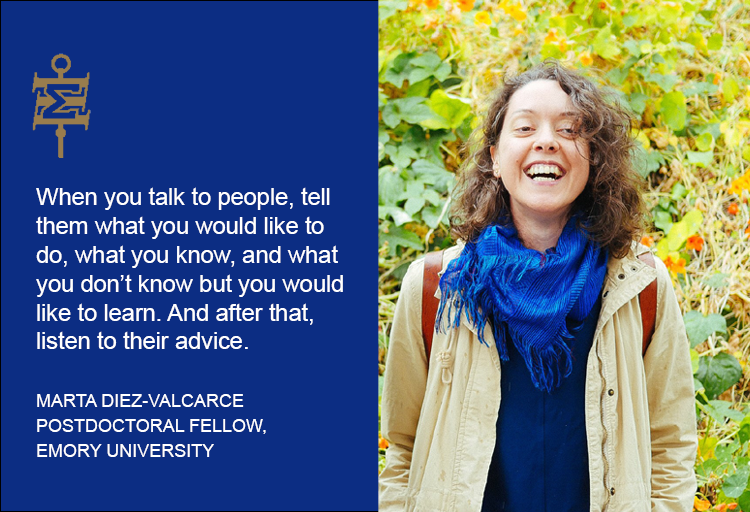
Current position
Postdoctoral Fellow at the Rollins School of Public Health, Emory University
Please describe your job.
I am a laboratorian working on viral gastroenteritis. My main research interests are studying the distribution and prevalence of virus gastroenteritis in different populations (mainly kids up to 5 years of age). The information we are gathering could:
- Improve the understanding of natural immune response to viral infections since birth
- Be used in the design, development, and implementation of vaccines for viral gastroenteritis
What are the top resources that have helped you in your career as a woman in STEM and why were they helpful?
PERSONAL RELATIONSHIPS. Network, meet people, reach out to people you admire (don’t be shy, most of the time people are happy to talk to other scientists that are genuinely interested in what they do). When you talk to people, tell them what you would like to do, what you know and what you don’t know but you would like to learn (that has proved to me to very important). And after that, LISTEN to their advice (it sounds easier than it actually is, at least for me, but when you do…then the magic happens).
Kelly K. Falkner

Current position
Director of the National Science Foundation’s Office of Polar Programs
Please describe your job.
I serve as director of the Office of Polar Programs (OPP), National Science Foundation (NSF) and so director of the U.S. Antarctic Program, which NSF manages on behalf of all the U.S. government in accordance with Presidential Memorandum 6626 and the terms of the Antarctic Treaty System. I am a member of the Senior Executive Service and currently oversee an annual budget of $600 million covering scientific research and logistics programs in both the Arctic and Antarctic. It is an exciting proposition to foster highest quality scientific merit review and pull all the diverse operational and cooperative pieces together necessary to sustain a world-leading polar research portfolio for the nation.
What are the top resources that have helped you in your career as a woman in STEM and why were they helpful?
“Resources” might not quite be the right word to express what has been most important to my career progression. Curiosity and resilience come to mind as qualities that helped me the most to remain motivated and overcome innumerable obstacles to advance my career as a woman in STEM.
I recommend that those who wish to pursue a career in STEM consciously cultivate curiosity for the fun and insights it generates. Surround yourself with people in schools, training programs, societies and other groups who pursue what makes them wonder and learn from them. Deliberately exercise curiosity so you don’t lose that ‘muscle’ we are all born with. The joy of scientific discovery and expanding knowledge rewards the curious.
While that joy may be at the core, it isn’t enough. You are going to need to draw on resilience; while it seems that all human beings long to belong, there will be times when you will feel like you don’t. Probe those feelings but don’t be overcome by them. If you feel the confidence slipping, pull out your resume and read it! Let your accomplishments speak to you; if you managed to get this far, you have what it takes to forge on.
Make it a point to pursue activities that fortify your resilience. For me that included taking regular breaks from STEM matters. The most important resources? Colleagues, friends and/or family who can help navigate the challenges as they inevitably emerge. Music, art, athletics, social gatherings, teaching others, volunteering; whatever it takes to keep your perspective healthy and balanced.
I applaud my fellow Sigma Xi members for pointing out extremely beneficial resources available to support people in STEM careers. I urge you to avail yourselves of them and may you remain curious and resilient in your personal STEM journey.
Ella A. Kasanga
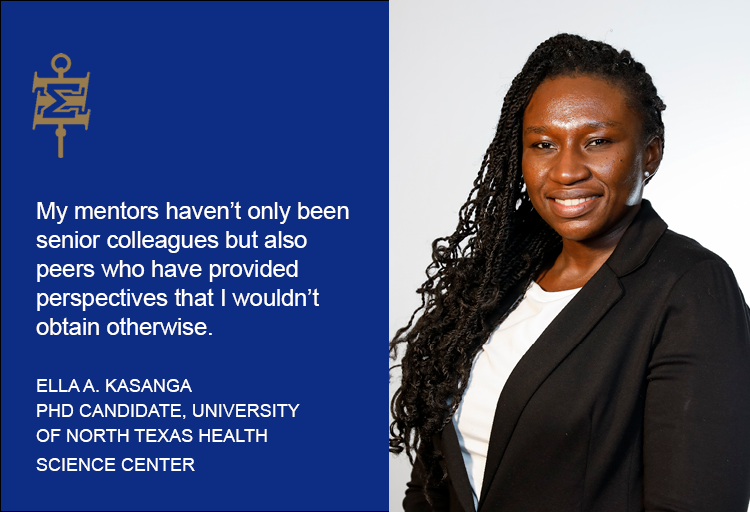
Current position
PhD Candidate at the University of North Texas Health Science Center
Please describe your area of study and research interests.
My area of study primarily focuses on identifying and understanding how motor impairment occurs in both aging and Parkinson’s disease. Additionally, my research includes identifying interventions, ie. lifestyle and medications, which may reduce the rate of locomotor dysfunction, as this condition takes a toll on both patients and caretakers. With the expected exponential increase in the aging population by the year 2030, the incidence of impaired movement initiation, with its associated consequences, is also expected to rise. Thus, research needs to be undertaken to determine what measures can be put in place to ensure that the elderly population live a healthy long life.
What are the top resources that have helped you in your career as a woman in STEM and why were they helpful?
Seeking advice from mentors is one resource that I have utilized throughout my undergraduate education as a pharmacy student to my graduate school education. I have garnered mentors who have provided advice and shared experiences which have guided me in my scientific career. My mentors haven’t only been senior colleagues but also peers who have provided perspectives that I wouldn’t obtain otherwise. The availability of mentors within STEM has been invaluable to my growth as a professional.
Apart from mentorship, attending conferences like the Sigma Xi Annual Meeting & Student Research Conference and the Society for Neuroscience (SfN) Annual Meeting is a resource that has proven very useful. The opportunity to interact with other researchers, exchange ideas, and form collaborations is a gift which shouldn’t be looked down upon especially in the era where collaborative science is gaining popularity. Most of these conferences also have specialized workshops which create an avenue to enhance one’s professional development. For instance at SfN, a special luncheon is organized for female scientists, creating a unique avenue to interact with both seasoned scientists and peers. This is an effective way of establishing one’s professional support system which is very important in every field.
Also, I have found the SfN Neuronline Platform very useful. This platform helps one expand their skills by providing scientific research, training, and professional development resources which may include videos, articles, interviews and virtual conferences. Having this diverse range of resources on one platform makes it very convenient for members to obtain much-needed information.
As a young woman who is gradually building her career in STEM, the experience can be quite overwhelming, however, I strongly believe that with the right resources and support system, a successful STEM career is definitely within reach.
Haixin Peng
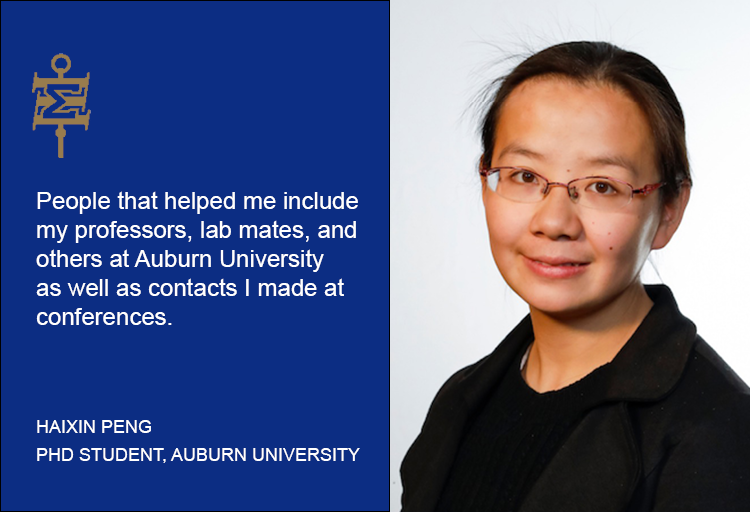
Current position
PhD student at Auburn University
Please describe your area of study and research interests.
I am pursuing a PhD at Auburn University, studying bioprocess engineering. My research focused on algae biofuel and food-production capability of processes. Microalgae are photosynthetic microorganisms with rapid growth and the potential for production of lipids, proteins, and carbohydrates. Our research team’s goal is to study the symbiotic interaction of algae and bacteria: 1) how bacteria regulates the algae growth in the application for waste remediation and water quality; 2) the development for algae high-value bioproduct applications such as omega-3 fatty acids, carotenoids, and polyphenols bioactive compounds.
What are the top resources that have helped you in your career as a woman in STEM and why were they helpful?
I am lucky to have access to so many resources that further my career as a woman in STEM. People that have helped me include my professors, lab mates, and others at Auburn University as well as contacts I made at conferences. I joined the Graduate Women in Science (GWIS) Auburn chapter, which has provided me support and advice from friends, peers, and staff mentors. I attended the 2019 Algae Biomass Summit, where I developed my research skills and enhanced my understanding of the scientific applications of algae. I also attended the Sigma Xi Annual Meeting and Student Research Conference, where people from diverse backgrounds gathered to learn together. I talked to many people both within and outside of my research area. The conversations I had with mentors there about my research and career goals helped me and encouraged me to pursue a future in this field.
Through all of these experiences, exposure to inspiring people has broadened my horizons, given me experience collaborating with diverse teams, taught me about various career possibilities, and helped me grow both personally and professionally. Besides talking to people, I gain perspective through reading books. Reading a good book is like making a good friend. In my spare time, I like reading biographies of remarkable women. My favorite book is the biography of Marie Curie, a good role model in my life and work.
Danielle Wood
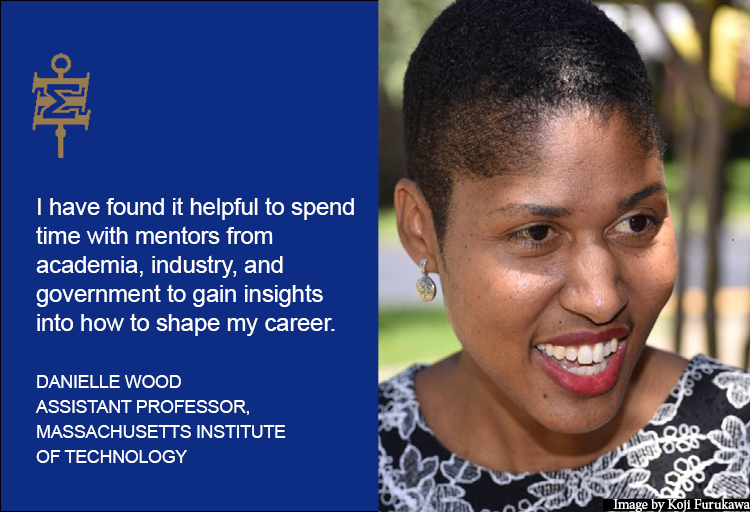
Current position
Assistant Professor of Media Arts and Sciences, Assistant Professor of Aeronautics and Astronautics, and Director of the Space Enabled Research Group at the Massachusetts Institute of Technology; MIT Faculty Contact for African and African Diaspora Studies; Visiting Associate Professor, Kyushu Institute of Technology (Japan); Sigma Xi Distinguished Lecturer
Please describe your job.
In 2018, I joined the faculty at MIT and founded the Space Enabled Research Group within the Media Lab, an interdisciplinary research center. The mission of the Space Enabled Research Group is to advance justice in Earth's complex systems using designs enabled by space. Our message is that six types of space technology are supporting societal needs, as defined by the United Nations Sustainable Development Goals. These six technologies include satellite earth observation, satellite communication, satellite positioning, microgravity research, technology transfer, and the inspiration we derive from space research and education.
While much good work has been done, barriers remain that limit the application of space technology as a tool for sustainable development. The Space Enabled Research Group works to increase the opportunities to apply space technology in support of the Sustainable Development Goals. Our research applies six methods, including design thinking, art, social science, complex systems, satellite engineering and data science.
We pursue our work by collaborating with development leaders who represent multilateral organizations, national and local governments, non-profits and entrepreneurial firms to identify opportunities to apply space technology in their work. We strive to enable a more just future in which every community and country can easily and affordably apply space-enabled technology to improve public services and solve local challenges. We also work to help improve the sustainability of activities in space by reducing the risk of space debris causing collisions that damage satellites. Finally, we think about future human activities in space when people will live in communities beyond Earth; we ask how we can create a foundation for just societies in space and on Earth.
What are the top resources that have helped you in your career as a woman in STEM and why were they helpful?
Throughout my career I have found it helpful to spend time with mentors from academia, industry, and government to gain insights into how to shape my career. When I was an undergraduate, spending time working in university research laboratories or government internships gave me valuable experience (see http://intern.nasa.gov/). I also participated in several international or national professional organizations as a volunteer, specifically the International Astronautical Federation (http://www.iafastro.org/) and the American Institute for Aeronautics and Astronautics (https://aiaa.org). As a graduate student I earned fellowships to support my education from NASA, the Department of Defense (NDSEG.asee.org) and the National Science Foundation (Graduate Research Fellowship Program). Each of these resources helped me find a path to select a research area and long-term career path focused on applying space technology to support sustainable development on earth and in space.
Andrea Armani
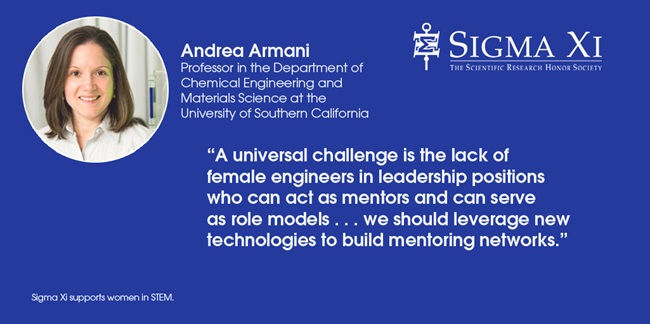
Current position
Professor in the Department of Chemical Engineering and Materials Science at the University of Southern California (UCS)
Please describe your job.
I am a professor of chemical engineering and materials science at USC. I lead a research group of enthusiastic undergraduate and graduate student researchers and postdoctoral scholars who are inventing new nanotechnologies to improve healthcare. I also teach classes, give research lectures and seminars, organize outreach events for the greater Los Angeles community, and oversee a core USC facility for nanoscience.
What challenges do you see for women working in, or studying, science, technology, engineering, or math?
Depending on the career stage, the challenges are very different. However, in many ways, a universal challenge is the lack of female engineers in leadership positions who can act as mentors and can serve as role models. Additionally, as a result of this imbalance, the few female scientists in leadership positions carry a disproportionate burden of outreach as compared to their male counterparts.
What do you think could be done to help overcome those challenges?
I encourage all of my students to identify researchers who are good mentors and to proactively contact them for advice. However, as a scientific community, we need to do better. We should leverage new technologies to build mentoring networks and more effectively utilize existing mentoring resources. We also need to recognize that demonstrating scientific leadership goes beyond scientific discovery. When evaluating scientific leadership for inclusion in the National Academies of Science, Engineering, and Medicine, a researcher’s contributions both in and out of the lab should be considered. In many ways, there are many possible opportunities for positive change, if the scientific community can work together.
Beth A. Cunningham
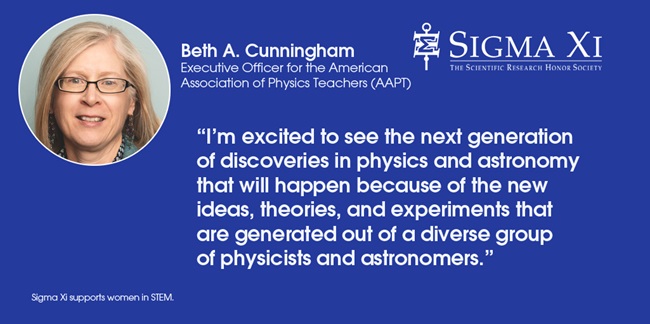
Please describe your job.
My position is to oversee the day-to-day operations of the American Association of Physics Teachers (AAPT) and to work in partnership with the AAPT Board of Directors in setting the strategic direction of the organization. AAPT is a professional membership association of physics educators dedicated to enhancing the understanding and appreciation of physics through teaching. AAPT has about 6,500 members worldwide that are educators who teach all levels, K–12 through graduate education. In addition to overseeing AAPT’s membership, programs, conferences, and finances, I am responsible for several special grant-funded projects including one to produce more highly quality K–12 physics teachers and another to increase the participation of women in the physics teaching profession, especially in higher education.
What challenges do you see for women working in, or studying, science, technology, engineering, or math?
Women, particularly women from underrepresented groups, face a number of challenges including implicit bias, stereotype threat, microaggressions, and, in some cases, explicit bias. These types of experiences can make women feel excluded and discourage them from considering or continuing in STEM careers. Physics may be considered an objective science but yet physics has a culture that has encouraged participation by only the “best and brightest” which has often meant white males. The challenge for many areas of STEM is how to change the culture to be more inclusive.
What do you think could be done to help overcome those challenges?
There are a number of ways to overcome these challenges including: finding spaces where women can talk about their challenges and develop solutions together; training allies, especially male allies, to support women when they experience biases and harassment; providing opportunities for all STEM professionals to learn more about the challenges women face in the workplace and the ways that women can be supported; providing mentors and sponsors to help women progress in their careers; and developing women and family-friendly policies in academia and the workplace. Professional societies have a key role in helping the community make changes since our members look to us for leadership. I’m currently working on a project that will challenge physics and astronomy departments in higher education in the U.S. to reflect on their policies and practices and develop action plans to make the cultural changes that are needed to retain the full range of talent. I’m excited to see the next generation of discoveries in physics and astronomy that will happen because of the new ideas, theories, and experiments that are generated out of a diverse group of physicists and astronomers.
Marcetta Darensbourg
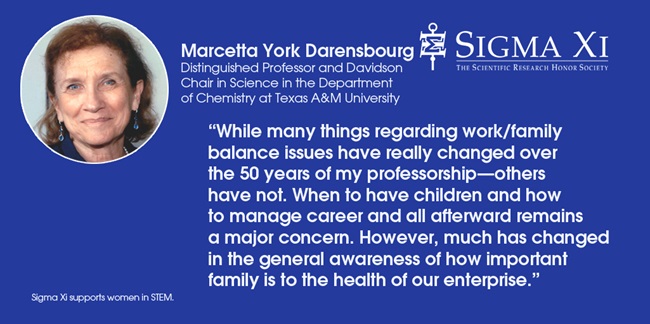
Current position
Distinguished professor and Davidson Chair in Science, Department of Chemistry, Texas A&M University; Fellow of the American Association for the Advancement of Science
Please describe your job.
As a professor I “profess.” I teach in lectures and direct a research group of eight to ten graduate students and two or three undergraduates. Teaching undergraduate chemistry majors predominantly keeps me grounded in fundamentals. Mentoring the graduate students keeps me informed on frontier research as well as creating frontier research.
As a member of an international community of scientists who work in my field of interest, I contribute with our research, organizing and attending conferences, reviewing papers and proposals; in these ways I also advertise the research component of my university.
What challenges do you see for women working in science, technology, engineering, or math?
While many things regarding work/family balance issues have really changed over the 50 years of my professorship—others have not. When to have children and how to manage career and all afterward remains a major concern. However, much has changed in the general awareness of how important family is to the health of our enterprise; how important it is to have a “life” outside of the lab or lecture hall; how important it is to support personal decisions; how important it is to have a support network. I owe so much to the women and men who fought for this awareness. Personal challenges persist, including getting recognition for ones ideas, not worrying if we appear to be overly aggressive when trying to speak as loudly as our male counterparts.
What do you think could be done to help overcome those challenges?
We are on the right track. Increasing numbers of women in the STEM jobs makes the field more attractive both within and for recruiting. Support groups and programs in universities and in national conferences that address challenges are frequently also attended by young men. Our challenges are not unique. We must persist and simply carry on.
Jordan B. Harrod
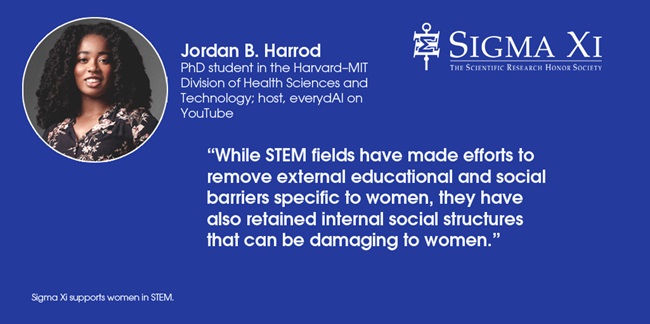
Current position
PhD student in the Harvard–MIT Division of Health Sciences and Technology; host of everydAI on YouTube
Please describe what you are working on at school and how that ties in to your career goals.
As a PhD student, my interests lie at the intersection of machine learning, electrical engineering, and neuroscience. I am currently rotating with Dr. Ed Boyden and Dr. Emery Brown with the goal of developing a closed-loop non-invasive neuromodulation system for a variety of clinical applications. Outside of the lab, I host a YouTube channel called everydAI which aims to educate the public on how we interact with artificial intelligence in our everyday lives, am involved in science writing organizations at Harvard and MIT, and engage in science policy advocacy.
At the moment, my career goals are leaning towards industry and entrepreneurship, as I would be interested in commercializing the products of my PhD. I’ve found that both the academic projects that I am working on and the mentorship of my advisors have supported these goals. However, I also plan to continue working on science communication and science policy throughout my career, which I am developing a skill set for through my extracurricular work.
What challenges do you see for women working in, or studying, science, technology, engineering, or math?
The field of biomedical engineering is actually fairly diverse in terms of gender (compared to other fields), but there are certainly still hurdles that women working in STEM fields face today. One of the bigger ones that I’ve noticed is that while STEM fields have made efforts to remove external educational and social barriers specific to women, they have also retained internal social structures that can be damaging to women, specifically as it pertains to the #MeTooSTEM movement. This is not to say that science should not be judged on merit, but to say that scientists who have sexually harassed their female peers and students should not be praised for their scientific work without equally acknowledging and addressing their wrongdoings. In addition, these social structures encourage superiors to suppress the voices of researchers, often women, who are trying to reform these systems by bringing those wrongdoings to light.
What do you think could be done to help overcome those challenges?
I think that continuing to highlight these wrongdoings will help the STEM community make strides towards overcomes these challenges, but I also think that the STEM community will have to consciously shift internal social structures to acknowledge that scientists are not exclusively defined by their science, but also by their impact on their communities.
Jarita C. Holbrook
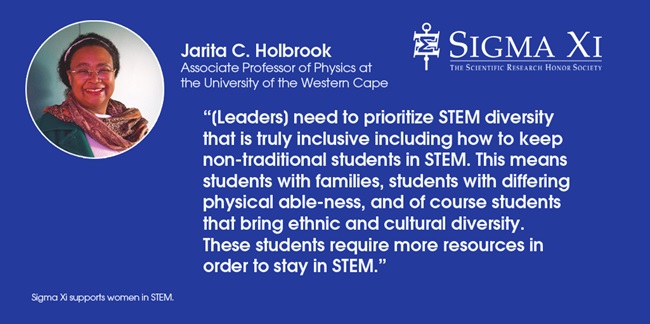
Current position
Associate professor of physics at the University of the Western Cape (UWC) in South Africa; filmmaker; astrophysicist; cultural astronomer
Please describe your job(s).
I am an associate professor of physics and astronomy. My research is interdisciplinary drawing from the social sciences under the umbrella field of cultural astronomy. I created and run the Astronomy & Society group at UWC. Right now I have three postgraduate students. We are trying to get articles out, get grant money, and they are working towards graduation. Data collection involves interviewing people connected to astronomy in folk settings, indigenous settings, or academic settings; also, I have a survey project that collects data online. A normal workday isn’t wildly exciting, I am sitting or standing in front of a computer editing articles, analyzing data, editing video, and preparing for my next excursion. I have a full travel schedule traveling internationally just about every month to give a lecture, attend conferences, or to screen one of my films. Also, I travel as part of my family science travel series, Science Tourist. As a filmmaker and videographer, I must maintain social media accounts that I tend to on the sixth day of the week, these are @astroholbrook (Twitter and Instagram) and @science_tourist/@thesciencetourist (on Twitter, YouTube, and Facebook). My job, which combines my knowledge of astronomy, my knowledge of astrophysicists, and the social sciences, is wonderfully suited to me.
What challenges do you see for women working in, or studying, science, technology, engineering, or math?
The challenge has to do with trying to change STEM culture to a culture that can recognize talent even when it doesn’t reflect the dominant culture. Many scientists think that they can assess a person’s intellectual ability in as short a time as five minutes of conversation! They then move forward with that limited judgment as if it is both valid and as if the judged person cannot learn, grow, and change. Also, I feel that scientists take advantage of the good will of young women who want to be helpful but dangerously assume that everyone is working to aid their success. The projects that will lead to publications, travel to conferences, and career advancement are patronizingly withheld from young women under the rubric of “they aren’t ready, yet.” Young women trust their advisor’s judgment until they don’t. Then they go through a cycle of disbelief, hurt, anger, evolving to rage and wanting to exit their discipline, because it isn’t just their advisor that has betrayed them, the other faculty are complicit. Being a good advisor means hitting that sweet spot of intellectually pushing your students without setting them up to fail, but always keeping them abreast of where you want to see them in the future: as colleagues.
What do you think could be done to help overcome those challenges?
Many ways to change the culture have been proposed and some of these have worked in many disciplines but not in all of STEM. Leadership is important, the leaders set the priorities and they need to prioritize STEM diversity that is truly inclusive including how to keep non-traditional students in STEM. This means students with families, students with differing physical able-ness, and of course students that bring ethnic and cultural diversity. These students require more resources in order to stay in STEM, and we need to make sure those resources are available.
As an aside, in South Africa, we are not just focused on transforming STEM, but are in conversations about identifying structural change to decolonize academia.
Ellen Ochoa
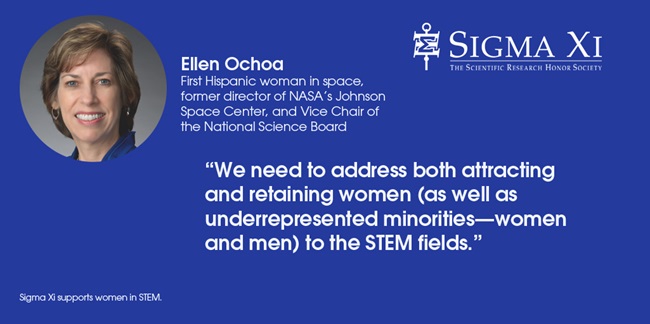
Current position
Vice Chair of the National Science Board. She was an astronaut, the first Hispanic woman in space, and the 11th director of NASA’s Johnson Space Center (JSC).
Please describe your career and what you are doing now.
I started out as a research engineer in optics, after getting interested in research from some summer positions. While I was in graduate school, the space shuttle flew for the first time and then started to demonstrate its many capabilities including supporting a variety of research. So I applied to the astronaut corps while working at Sandia National Labs and later NASA Ames Research Center. I was fortunate to be selected and then flew on four missions—two studied ozone depletion and two were part of the assembly of the International Space Station (ISS). I then had a number of management and leadership positions, culminating in 5.5 years as the director of Johnson Space Center, where our talented team was focused on operating ISS, teaming with companies developing crew vehicles to get to and from low earth orbit, developing a new spacecraft for beyond low earth orbit, and much more. After an amazing 30 years at NASA, I now pursue a variety of activities, including serving as vice chair of the National Science Board, which both sets policy for the National Science Foundation and also provides advice to the Administration and Congress on the science and engineering enterprise in the U.S.
What challenges do you see for women working in, or studying, science, technology, engineering, or math?
While the representation in these fields is much better than when I started out, women in most STEM fields still don’t see a lot of other women, and that’s especially the case in computer science, electrical engineering, and physics. Often, women don’t have the same opportunities as men, such as participating in training and development programs, leading teams, or being prepared for and selected for promotions. However, many organizations are now much more aware of unconscious bias and have changed some of their processes to help address it.
What do you think could be done to help overcome those challenges?
We need to address both attracting and retaining women (as well as underrepresented minorities—women and men) to the STEM fields. Some of the actions that organizations and individuals have undertaken, which I have personal knowledge of particularly in my role as director of JSC, include:
-
Getting the stories of women in the field more broadly disseminated (see, for example, the Women@NASA website, including through social media
-
Targeting materials and programs for middle school girls, before they start to make choices in high school that limit their options
-
Providing both mentors and sponsors in college, graduate school, and early in the professional career
-
Ensuring that women are fairly represented in training and development programs
-
Utilizing (diverse) panels for promotions and awards rather than a single individual
-
Advertising both formal and informal opportunities in the work environment (e.g. leading or participating on an ad hoc team) so that women can express their interest, rather than having a supervisor just select someone, which is often the same person over and over
-
Supporting Employees Resource Groups, which provide informal leadership opportunities, help an organization attract and retain women and other members of underrepresented groups, and increase employee engagement
-
Implementing a strong harassment policy including multiple avenues for people to report issues
Kate Richardson
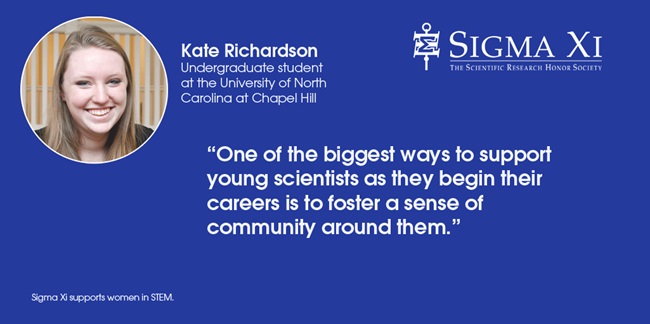
Current position
Top presenter in the Math and Computer Science category of the Undergraduate Division at Sigma Xi’s 2018 Student Research Conference; undergraduate student at the University of North Carolina (UNC) at Chapel Hill.
Please describe what you are working on at school
I am double majoring in physics and computer science at the University of North Carolina at Chapel Hill. Physics is the perfect major for me because I constantly ask the question “why?” to try to understand the most fundamental of the driving forces behind what we observe. I chose computer science as my second major because coding is the lingua franca of modern physics research. I plan to complete an honors thesis on the search for axion dark matter, which is a theorized particle that would solve two currently unexplained phenomena: the strong CP problem (the violation of charge conjugation parity symmetry in the strong interaction) and the need for matter outside of the standard model. I want to go on to earn a PhD in particle physics by studying dark matter and become a professor to continue contributing to dark matter research and the understanding of currently unexplained phenomena. Professors are not only researchers—they also mold the next generation of scientists. I have been lucky to have some of the most wonderful mentors, and I look forward to providing that for other early career scientists.
What challenges do you see for women working in, or studying, science, technology, engineering, or math?
Women face harassment and disregard from their superiors and peers that stops them from pursuing STEM. Additionally, not being able to have mentors that look like you is a deterrent in and of itself for young scientists. The underrepresentation of women in STEM fields is a harmful cycle: the lack of experienced professional women in STEM hurts young scientists of both sexes early in their careers, which contributes to the lack of female graduates. In 2017, only 18 percent of physics PhDs were awarded to women, according to the American Physical Society. In my experience, I have been underestimated in the classroom by both my peers and educators. This has inspired me to work to prove myself to anyone who doubts me. I have had multiple people tell me that I will not be able to complete my double major, which has strengthened my resolve to persevere when I face challenges.
What do you think could be done to help overcome those challenges?
I think that one of the biggest ways to support young scientists as they begin their careers is to foster a sense of community around them. For example, I am part of a scholarship program at UNC for underrepresented minorities in STEM, the Chancellor’s Science Scholars (CSS). CSS and the Women in Physics club have provided me support and advice through peer and staff mentors and friends with similar realities. I am constantly reminded of and try to live by the CSS motto: “If excellence is possible, then good is not enough.” Groups like this provide students with mentors and peers that share their experiences and want to support them. I think that there should be a push to start groups like this even earlier than college because I met one of my own most influential mentors in high school.
Sonya Smith

Current position
My job as a professor is to educate students through teaching and research. My favorite part of my job is to involve students in my research projects. It is such a joy to see them apply the principles they have learned in class to create new knowledge through research. I also consider it my responsibility to develop the next generation of women in STEM, particularly women of color.
What challenges do you see for women in science, technology, engineering, or math?
The main challenges for women working in STEM fields are the toxic climate and culture in which they often find themselves. There is much research on strategies to help women cope with, and navigate, hostile work climates: the so-called fix-the-women approaches. However, these types of approaches are not enough. Hostile climates and toxic cultures are much harder to address because it requires constant vigilance and a willingness to act on the part of administrators. Unfortunately, there is often retaliation against those who report problems rather than assistance. Until toxic climate/culture is remediated, it will not matter how many people we add to the pipeline. They will eventually leave.
What do you think could be done to help overcome those challenges?
This is very tough question because climate and culture results in part due to toxic behavior that has been normalized over time. However, in many cases, enforcing existing policies is a good start to remediating toxic climates and cultures. Paraphrasing from Martin Luther King, Jr.: It may be true that the policy enforcement cannot change the heart, but it can restrain the heartless.
Sudharshana Apte
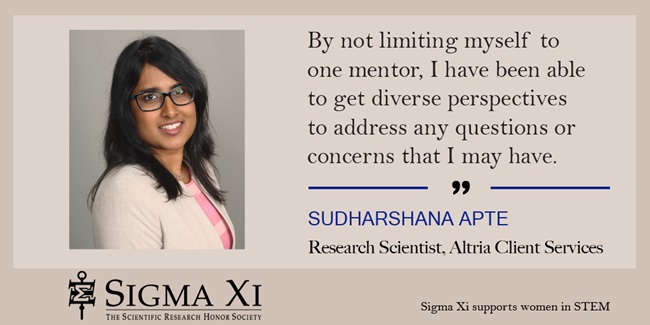
Current Position
Research scientist at Altria Client Services and president-elect of the Forum for Women in Operations Research and Management Science
Please describe your job.
In my current role as a research scientist at Altria Client Services, I utilize mathematical and statistical approaches to analyze real-world dynamic systems and propose solutions that result in process efficiencies. I am motivated by the applicability of the research problems I pursue and play a key role in providing actionable insights that drive business decisions.
My commitment to promote underrepresented groups also has me serving as president-elect of the Forum for Women in Operations Research and Management Science (WORMS). My goal is to increase representation of OR/MS professionals within the membership of the larger organization, to be able to provide mentorship opportunities for young women looking to start a career outside of academia.
Was a mentor important to your career success? If so, how did you find this person and how did she or he help you?
Absolutely! I have been blessed to have been surrounded by positive role models that have encouraged me to be the best version of myself, both personally and professionally. I have found that routinely interacting with people you find inspiring teaches you a lot of what you need in order to be successful. When you reach a level of comfort with that person, you are able to have honest conversations about your career goals and identify paths to help you attain them.
I have a broad set of individuals (both men and women) as my mentors: my professors, colleagues (both peers and superiors), and people in my field that I have become acquainted with at conferences. By not limiting myself to one mentor, I have been able to get diverse perspectives to address any questions or concerns that I may have. When in doubt, these are the people I turn to.
What advice or lessons helped you as you built your career?
The best advice I received was to stay authentic and courageous. This required me to undergo a certain level of introspection. By identifying my core strengths and focusing on developing them, I have been able to create a unique brand for myself. This has enabled me to, both, grow as an individual and influence how others perceive me.
Oh, and do not underestimate the power of networking when you are looking to build your career: be deliberate and strategic.
Maria Cruz-Torres

Current Position
Senior sustainability scientist and an associate professor at Arizona State University
Please describe your job.
I am an associate professor who teaches, conducts research, and mentors undergraduate and graduate students. I have conducted research on fisheries and aquaculture and I am currently working on a new research project examining the various factors that impact food security in tropical island ecosystems.
Has a mentor been important to your academic success? If so, how did you find this person and how did she or he help you?
Mentoring has been key to my academic career because I am the first one in my family to attend college and earned a PhD. I did not have many role models growing up, although my parents always encouraged and supported me to attend the university.
I have had two very important mentors in my career: Dr. Alida Ortiz and Dr. Bonnie J. McCay. The first was my professor when I was pursuing my undergraduate degree in marine biology. I took a course with her and that changed my life. She taught me how to conduct research and encouraged me to pursue graduate studies in anthropology. The later is another professor who I first met as an undergraduate, and she became my doctoral advisor. Both are very successful scholars and they taught me how to be persistent, to never give up, and not let anyone else define me.
What advice or lessons have helped you as you built your research career?
Be passionate about what you do even if others do not understand what you are doing or why.
Jennifer Patterson
Current Position
Chief Scientific Officer of BIOFABICS in Portugal
Please describe your job.
I am currently working as chief scientific officer of BIOFABICS, a biomedical start-up company that is focused on the research and development of 3D biotissue analogues. The company was founded in Portugal in August 2017. In particular, we develop tailor-made implants for research in tissue regeneration and customizable experimental setups for studying cell behavior in situations that mimic the body as well as for drug discovery and testing. Our goal is to provide expertise, design, and fabrication of devices for researchers at companies or universities who are looking for novel, more accurate, and more reliable tissue models.
As chief scientific officer, I am responsible for guiding/supervising the scientific research activities at the company and for helping to write grant proposals for research projects. However, since we are just starting up, I have also been involved with many aspects of the company, like developing some of the content for our website (www.biofabics.com).
Was a mentor important to your career success? If so, how did you find this person and how did she or he help you?
Many mentors have been important to me throughout my career. One that I would highlight is my senior thesis advisor from my undergraduate studies at Princeton University, Professor Michael Hecht. Professor Hecht actually nominated me for membership in Sigma Xi in 1998, and he cemented my interest in a research career by allowing me to pursue a very interesting and independent research topic for my senior thesis, which involved using transmission electron microscopy to look at the structure of novel proteins that had been designed in his lab. The research led to me being a co-author on a publication in Proceedings of the National Academy of Sciences. Professor Hecht also provided helpful career guidance, serving as a reference for my first job and also for my applications to graduate school. We have kept in touch over the years, and he was someone I could turn to for advice while going through a career transition a couple of years ago.
My first research mentor, Professor Jonathan King, whom I worked with through a summer research experience for undergraduates at MIT, was the first who got me interested in biochemical/biomedical research. While working for the company Therics Inc. after graduating from college, my boss, Dr. Kathy Chesmel, and our company co-founders, Professor Linda Griffith and Professor Michael Cima, helped to develop my research interests in tissue engineering and 3D printing, and they were also very supportive of my eventual decision to pursue a PhD by offering suggestions of programs to apply to and by serving as references.
Last but not least, I initially sought out Professor Patrick Stayton and Professor Jeffrey Hubbell, my graduate and postdoctoral advisors, respectively, because I was very interested in the research going on in their labs. However, I came to value them not only for their insight and scientific input on my research but also for their help in furthering my career. While I know how busy both are with research/teaching/travel/family, they have always been very responsive when I have reached out for career advice or for a reference letter.
What advice or lessons helped you as you built your career?
When I was deciding where to go for graduate school, I was given the advice to go to the University of Washington, in part because it has a great program in bioengineering but also because moving to Seattle would provide a different perspective from the Pennsylvania/New Jersey area where I had spent the first 25 years of my life. Since then, I’ve taken this even further, moving to Switzerland and Belgium and now being involved with a start-up in Portugal. As a result, I have come into contact with people who have diverse backgrounds and have experienced different working environments, and this has helped me to grow both personally and professionally.
Another lesson that I have heard often is that to be successful in research one needs to be persistent. While this is true, I think it is even more important to be resilient. Careers in research are tough. Often experiments don’t work, leading to unexpected results or requiring additional troubleshooting. The career path can be daunting, with many positions and also research funding being highly competitive. Learning how to move forward from setbacks and stay positive is essential.
Mary Woolley
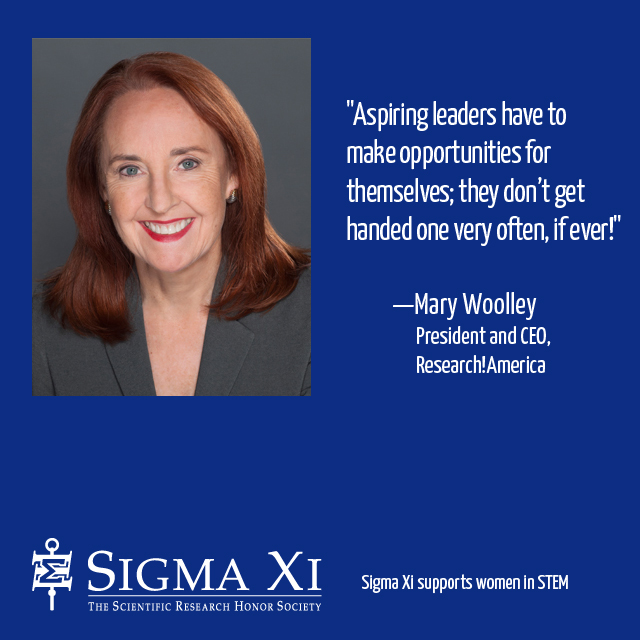
What is you current position?
President and CEO of Research!America.
How would you describe your job?
I work at the very exciting intersection where research and innovation meet the political and policy environment. We are an in-the-moment organization, so it’s a new challenge every day. Keeping a finger on the pulse of public sentiment toward science is a dynamic part of our work with which I am personally engaged—it’s absolutely essential in developing effective advocacy. In the broader picture, I am privileged to work with, for, and around some of the smartest, most accomplished and most highly regarded people in our nation. Career fulfillment doesn’t get any better than that!
As a nonprofit alliance of nearly 400 institutional and organizational members, Research!America works to help the medical and health research ecosystem—which very much includes the patient community—speak with one voice when making our case to policymakers, the media, and the public. It’s highly motivating to know that advocacy can continue to help speed the day when the hard work of research and innovation will pay off in new treatments, cures and preventions—finding solutions to what ails us as individuals, communities and as a nation.
It’s also motivating to find the many—and there are many—ways the overall science community can benefit from working together in advocacy. That’s an increasingly important part of our work, and I relish it thoroughly.
What is a challenge that you have had to overcome as a woman in STEM?
It’s often said that challenges are opportunities in disguise, and that describes many of the challenges I have faced! For example, it can be difficult to be the only woman in the room—including in the boardroom. Social science research confirms that having a single “token” of any group whether based on gender, race or ethnicity, age, or political ideology is not helpful to a board or its mission. And it can be isolating for that individual.
How did you overcome this challenge?
It’s important to speak up and provide fresh perspectives—to focus on making your presence an opportunity for that board to re-think its composition and to realize greater value going forward. Volunteering to serve on the nominating committee of a board of directors is a good way to help broaden the sights of a board that is perhaps “too male and too pale.”
It’s also a good plan for a woman stepping onto a board to get involved immediately in the finance work of the board. This step is often outside the expertise of a STEM-educated or experienced individual, whether they are male or female, so it can be an opportunity to learn that shouldn’t be overlooked. Aspiring leaders have to make opportunities for themselves; they don’t get handed one very often, if ever!
Hayriye Merve Yurdacan
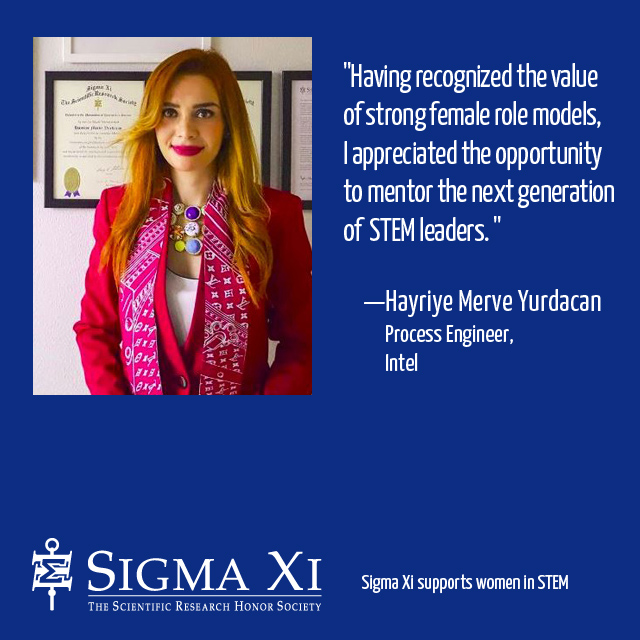
What is you current position?
Process engineer at Intel and the Southwest Regional Representative on the Sigma Xi Committee on Nominations.
How would you describe your job?
I work as a process technology development engineer at Intel to create industry-leading semi-conductor technology. To accomplish this, I am a part of multi-disciplinary engineering team responsible for process and equipment development. My work includes process design, utilizing equipment for optimal manufacturing conditions and finally transferring these conditions to factories across Intel.
In addition, I have been working with University of Southern California on various research projects including mechanical, thermal, and optical properties of polymers and development of high performance nanocomposite membranes for water reclamation and nanofiltration. It is a highly interdisciplinary research that combines chemistry, chemical engineering, environmental engineering, and materials science.
What is a challenge that you have had to overcome as a woman in STEM?
Women in STEM face many challenges. I would describe STEM experience as a strong wind that constantly drags you into new adventures and challenges. The biggest challenge I have ever faced was in grad school when I was a team leader/head teaching assistant where I led and trained large groups of chemistry TAs for five years. Moreover, this group of TAs changed every semester, which meant I had to work with different groups of people from different cultures and backgrounds each time.
Being a female leader in STEM presented a new set of difficulties. First, it was hard to find a female mentor and role model in a STEM field who was in similar circumstances to those I faced. Second, there were times when I felt my voice was not heard. I had to work much harder to make sure my voice was heard in this male-dominated environment. There were times I felt like my authority and opinion were challenged by others while I was leading the team.
How did you overcome this challenge?
I recognized that while you cannot change the behavior of others, you can change how you respond to it. Once you succeed in being self-confident you become less dependent and sensitive to the environment, giving you a more objective view and allowing you to be more present in public.
Establishing good communication with my team was also another approach that improved our cohesiveness. I found that improved communication lessened our misunderstandings and improved our mutual respect. In addition, I became a mentor to both female and male undergraduate students. Having recognized the value of strong female role models, I appreciated the opportunity to mentor the next generation of STEM.
Lindy Elkins-Tanton
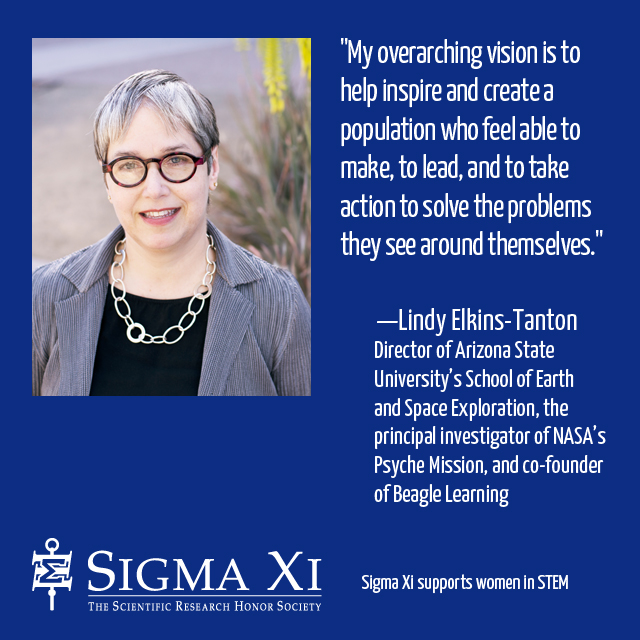
What is you current position?
Director of Arizona State University’s School of Earth and Space Exploration, the principal investigator of NASA’s Psyche Mission, and co-founder of Beagle Learning.
How would you describe your job?
My job at ASU is to make the jobs of all the faculty and staff easier, if I possibly can, and to find all the ways I can to support the goals and visions of students, faculty, and staff. My overarching vision is to help inspire and create a population who feel able to make, to lead, and to take action to solve the problems they see around themselves. After years of thought, I think that is the core need for humanity’s future. And it is reached through education.
What is a challenge that you have had to overcome as a woman in STEM?
There is a fairly pervasive attitude in science and engineering that the emotionality of a situation or one’s personal feelings are irrelevant, and possibly even damaging and distracting from the objective task at hand. From this springs the idea that skills like team building and leadership coaching are either unimportant or easily achieved through common sense. Team building and leadership, however, are critical skills that lead to inclusion and diversity. Without a culture that allows anyone with the skills needed to succeed, no number of hiring rubrics will solve the problem of a group without diversity. It’s the culture that allows for success.
How did you overcome this challenge?
I talk unembarrassedly about culture. Speak and write politely to each other. Invite quiet people to speak their opinions. Don’t tolerate personal attacks or temper tantrums. This kind of culture produces success. People are unafraid to bring up potentially critical issues in an engineering design, for example. People are willing to ask the naïve questions that often produce the most innovative, interdisciplinary science. And large funding agencies understand the importance of functioning teams. So it’s not weakness or irrelevancy—a positive culture directly supports both success and diversity in science and engineering.
Catherine Kitonde
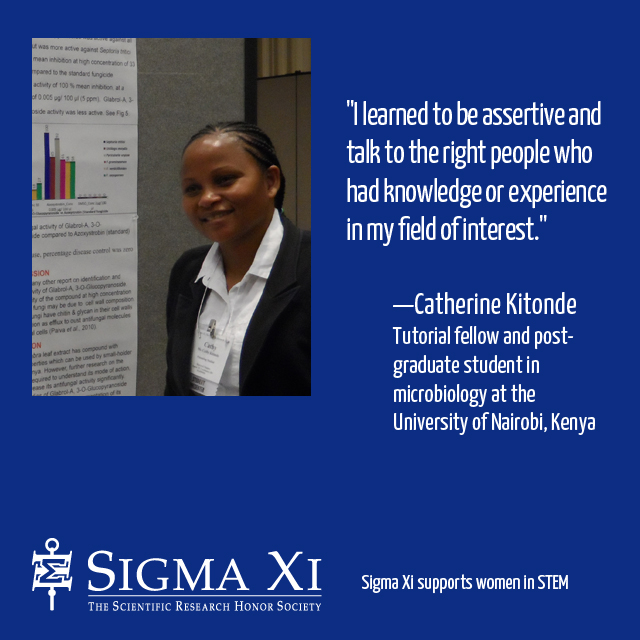
What is you current position?
Tutorial fellow and a post-graduate student who is studying microbiology at the University of Nairobi, Kenya.
How would you describe your job?
As a tutorial fellow, I am involved in optimal delivery of lectures and practicals in the thematic group. I also conduct PhD research in microbiology. My research is focused on the use of natural pesticides (sprays) to manage pathogens causing diseases to our crops.
What is a challenge that you have had to overcome as a woman in STEM?
Lack of equipped laboratories is a big problem in some African high schools and universities. As a woman, I had interest in STEM but it was difficult to achieve set research goals or objectives due to lack of equipment to conduct sound research.
In addition, I came from a poor background so it was not easy to pursue STEM or take any other program in the university. Poverty leads to many difficulties when in school and may lead to poor performance (poor grades) if there is no support provided and you end up not succeeding in taking STEM programs.
Poverty in Africa, especially in Kenya, has made many girls drop out of school to work and earn small wages for their survival, while others go for early marriages whereby we end up having communities with uneducated women (the leaky pipe) and very few end up taking STEM programs. Even those who take STEM may not take high positions in higher education institutions or research institutions dominated by their counterparts.
Also in Africa, some think that science is made for boys. They think that mathematics is hard, physics is hard, and engineering is hard. It’s only that they never thought of the determination and passion for it and say, “I’m going for it.” I got into microbiology because I was very curious about how and why phenomena happen. I also wanted to make new discoveries.
How did you overcome this challenge?
A curious person is always asking questions and looking for answers. Through that, I came to find that I love research. I fight for what I like. Sometimes it was not easy to conduct research and attend tuition, but I found a mentor (Prof. Lucy Irungu). It is advisable to be proactive—when she mentored me I was responsible for taking the lead. That is why I am where I am today as a tutorial fellow and a PhD microbiology student at the University of Nairobi.
I am eager to finish my studies soon and start conducting meaningful research with a determination that I will lead a big team of researchers, just like professors do. Therefore, I feel that I am in the right place to conduct research in the university and learn to solve societal problems.
I did my PhD work at Dow AgroSciences, Indiana, USA. Before I went to Dow AgroSciences, I won an AWARD Fellowship, which stands for African Women in Agricultural Research and Development. AWARD is a career-development program that equips top women agricultural scientists across sub-Saharan Africa to accelerate agricultural gains by strengthening their research and leadership skills through tailored fellowships. It is a catalyst for innovations with high potential to contribute to the prosperity and well-being of African smallholder farmers, most of whom are women.
During my AWARD Fellowship at Dow AgroSciences, I learned that without equipped labs in Africa I can collaborate with developed labs to conduct quality research and help solve problems in the society. I would encourage universities and research institutions/companies from developed countries to collaborate with African universities and research institutions by increasing the number of scholarships, especially for bright girls and women from poor backgrounds, to increase the number of women in STEM who can take high positions and make sound decisions in higher education and research institution dominated by their counterparts.
Dr. Namandjé N. Bumpus
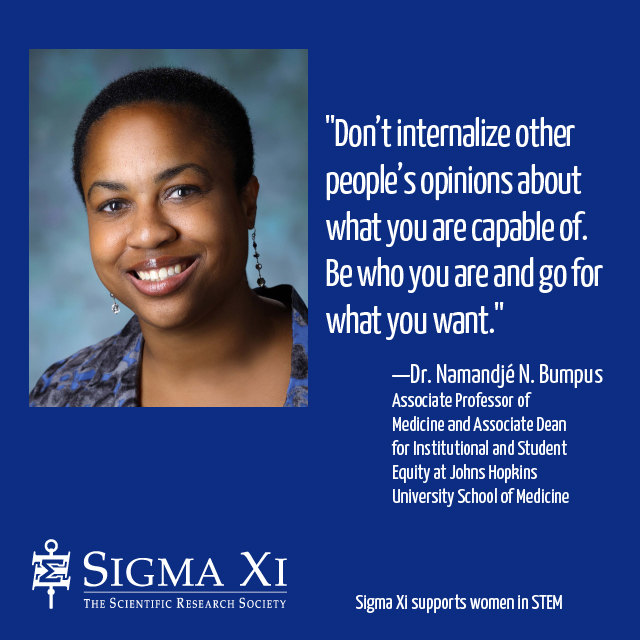
Current position
Associate professor of medicine and associate dean for institutional and student equity at Johns Hopkins University School of Medicine.
Description of your job
I am a pharmacologist. I spend the majority of my effort on research. My lab studies drug metabolism and we focus in particular on how drug metabolism mediates inter-individual variability in anti-HIV drug response. In this role, I mentor graduate students that are pursuing their doctoral research in my laboratory. In addition, I play a role in the mentoring of students more broadly as part of my administrative position working in the area of student equity.
What do you see as your biggest contribution to your field?
Our group has identified mutations in drug metabolizing enzymes that may predispose a person to treatment failure when they are dosed certain anti-HIV drugs.
I work in STEM because...
I love working with students interested in STEM and learning something new every day.
Dr. Tessa M. Hill

Current position
I am an associate professor at UC Davis, in the Department of Earth & Planetary Sciences. Much of my work is based at Bodega Marine Lab, our amazing field station on the Northern California coast.
Description of your job
My job includes many different things! I do field and laboratory research on the impacts of climate change on marine environments in the past and present. One of the best parts of this work is mentoring undergraduates, graduate students, and postdoctoral scholars as they pursue their research and career goals. I also teach oceanography courses at UC Davis, at both the undergraduate and graduate level.
Another really exciting and fundamental part of my job is that I talk to other scientists, and to people outside of the university, about the impact of climate change on the ocean. I also work with future K-12 science teachers to develop climate change curriculum that they can use in their classrooms.
I work in STEM because...
It is exciting and important. I get to ask interesting questions and help chip away at our understanding of big problems.
Dr. Omowunmi A. Sadik
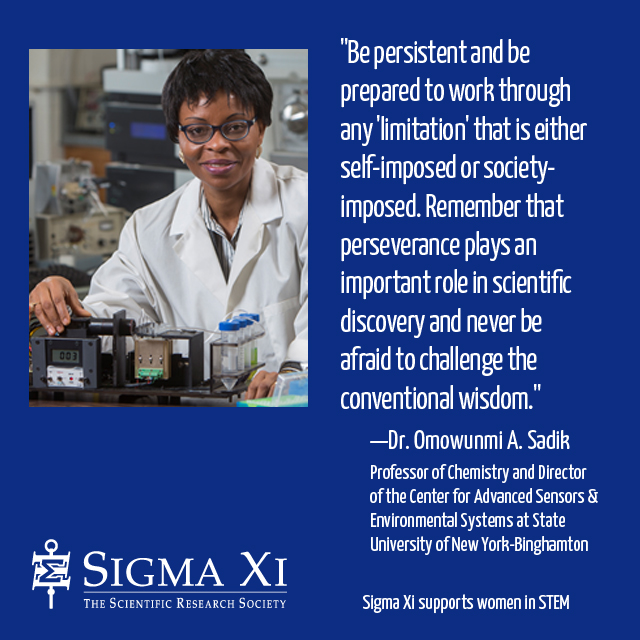
Current position
Professor of chemistry and director of the Center for Advanced Sensors & Environmental Systems at State University of New York-Binghamton
Description of your job
As a professor of chemistry and the director of an organized research center, my job involves teaching, conducting research, and participating in professional services. My teaching includes a wide variety of academic and research subjects; I also conduct research and I publish the results of my research findings in technical journals, which includes scholarly papers and books/book chapters. I give technical lectures worldwide in my areas of expertise. I spend a large portion of my time conducting research and applying for grants to fund my research programs. Specifically, I teach graduate and undergraduate courses in introductory chemistry, quantitative chemical analysis, instrumental analysis, biosensors, and environmental chemistry. Sometimes the enrollments in these classes vary: some are very large with several hundred students and I do this usually with the help of several graduate teaching assistants. Other classes are small comprising about 40–100 students, and sometimes there are graduate classes with just a few students. In addition, I also supervise research laboratories where students work on specialized subjects in my areas of expertise. These include doctor of philosophy (PhD), master of science (MS), and bachelor of science (BS) students.
One aspect of being a professor is that I must keep up with new developments in my research field by reading scholarly articles, and participating in professional conferences, seminars, and workshops.
Regarding professional services, I serve on my university committees, departmental committees, or as a member of the editorial boards of professional journals. Finally I serve as a reviewer of scientific articles submitted to technical journals, and on the review panels/committees for grant applications submitted to funding agencies. I have served in elected positions of scholarly societies.
What do you see as the biggest contribution to your field?
A core objective of my research program is to understand the mechanisms of how chemical information is transformed from one interface to another, and to use that knowledge to develop innovative sensing technologies, functional materials, and devices. We are conducting groundbreaking research in biosensors leading to the development of new diagnostic tools and detection devices for various medical, environmental, and food applications. I have authored or co-authored over 160 scientific publications and I have given over 350 invited lectures and conference contributions worldwide. Some of my publications have appeared in very reputable scientific journals such as Nature Nanotechnology (in review), ACS Nano, RSC Advances, Langmuir, ACS Catalysis, Chemical Communication, and Biosensors & Bioelectronics. I have five U.S. patents as well as other pending patent applications. I successfully led my team of researchers to translate basic research in biosensors into the design and fabrication of a prototype portable, fully autonomous, and remotely operated sensing device known as U-PAC™ (Ultra-Sensitive Portable Capillary Sensor). This devise exhibits superior performance for detecting proteins, nucleic acids, and E-coli with 4-fold lower detection limits than conventional ELISA techniques and the results are displayed within minutes.
I work in STEM because...
I am passionate about using fundamental knowledge of science to solving problems in the broader world around us. Being a university professor provides me the opportunity to impact the development of career scientists—from the crucial undergraduate years through the doctoral and post-doctoral levels. Out of the 30 PhD and MS students that I have mentored to date, 10 have secured faculty positions in leading universities around the world; others are employed in the industries and at national laboratories in the United States. As the president and co-founder of the Sustainable Nanotechnology Organization (SNO), I am also promoting the responsible growth of nanotechnology around the world through research, education, and outreach. Through SNO, I am making science accessible to lay audiences and to those that have traditionally have been excluded from the process of science.
Dr. France A. Córdova

Current position
Director of the National Science Foundation (NSF)
Description of your job
It is a tremendous honor to serve as director of NSF. I was nominated by President Barack Obama to lead the nation’s only federal science agency whose mission covers both education and fundamental research across all fields of science discovery, technological innovation, and science, technology, engineering, and mathematics (STEM) education.
The scope of NSF research is immense and I’m proud to be a part of a legacy that has led to barcodes and Doppler radar, catalogued languages and decoded genomes, and the creation of Google and the internet as we know it. NSF has supported 217 Nobel Prize winners and hundreds of small businesses. It is this kind of support that enhances our nation’s security, drives the U.S. economy, and advances our knowledge to sustain global leadership.
Our mission, first and foremost, is turning the bold ideas of today's scientists into tomorrow's realities. A wonderful example of this is the recent discovery of gravitational waves, detected 100 years after being predicted by Albert Einstein first predicted them. This discovery, made by a NSF-funded facility known as LIGO, and a host of scientists from around the world, opens unprecedented new window to the cosmos.
Top professional accomplishments
I’ve had a long career in academia. I served as president of Purdue University. I also led the University of California, Riverside as chancellor and was a distinguished professor of physics and astronomy.
I served as NASA's chief scientist and won the agency’s highest honor, the Distinguished Service Medal. Before joining NASA, I led the department of astronomy and astrophysics at Pennsylvania State University. I also worked in the Earth and space sciences division at Los Alamos National Laboratory.
More recently, I served as chair of the Board of Regents of the Smithsonian Institution and on the board of trustees of Mayo Clinic. I was also a member of the National Science Board (NSB), where I chaired the Committee on Strategy and Budget.
I received my bachelor of arts degree from Stanford University and my doctorate in physics from the California Institute of Technology. I worked in both observational and experimental astrophysics, as well as multi-spectral research on x-ray and gamma ray sources and space-borne instrumentation, and have published more than 150 scientific papers.
I work in STEM because...
I work in STEM simply because the possibilities, surprises, and rewards are endless. I am driven by possibility, by the chance to discover something new. As a young girl I was enchanted by the mysteries of the night sky, and that early passion eventually lead me to astronomy. I’ve had a handful of life-changing moments as a scientist: the night I launched a rocket payload to detect collapsed stars, the day I saw the telltale signal in my satellite data of the X-ray pulsations of an accreting star. And I’ve had many highlights in my time as NSF director: helping break ground for a new telescope high in the Chilean mountains, touring a high-tech ocean research vessel. But what I enjoy most is talking with students from across the country about their scientific passions and goals. We must support these students, and ensure they represent the diversity of America. The key is to spark curiosity in science and math at an early age, then give woman and girls every opportunity to nurture that curiosity.
Dr. Jennifer L. Miksis-Olds
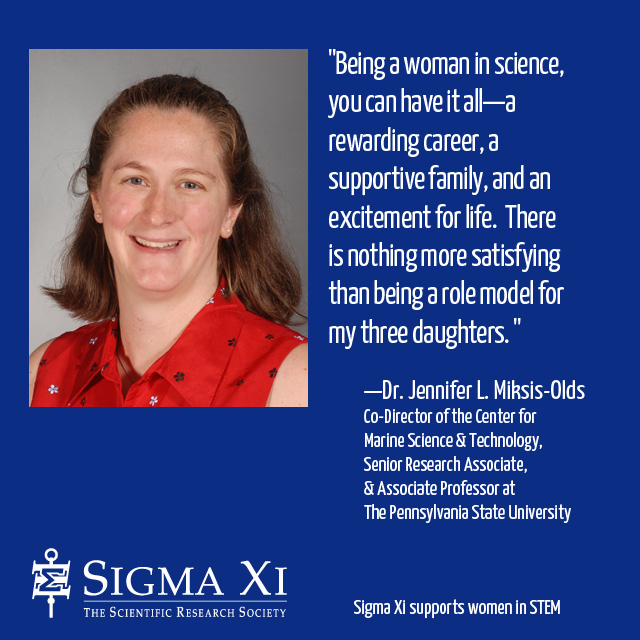
Current position
Co-director for the Center for Marine Science & Technology at The Pennsylvania State University. I'm also a senior research associate in the Applied Research Laboratory and an associate professor in the Graduate Program in Acoustics at Penn State.
Description of your job
I’m primarily research faculty that teaches a specialty graduate level course every one to two years. I work in the field of bioacoustics which means I use acoustic technology to study life in the ocean. My field is a combination of knowledge from biology, ecology, oceanography, engineering, and physics. Being so interdisciplinary is fun because it allows me to easily communicate with researchers from many different topic areas. I spend four to six weeks at sea each year, which is an exciting break from data analysis in the office. I enjoy working with students and involve both graduate and undergraduate students in my lab. I love my job because I find myself doing different things each day, and I’m constantly learning from my colleagues and students. As co-director of the Center for Marine Science & Technology, I’m tasked with raising the visibility of ocean science within the land-locked community of Penn State and the national science community.
What do you see as your biggest contribution to your field?
My biggest contribution to the field was developing SeaBASS: A Marine BioAcoustic Summer School. Marine bioacoustics is a small but highly interdisciplinary field, and no one university has the in-house expertise to provide a full degree program on this topic. SeaBASS was created as a week-long course to train the next generation of marine bioacousticians. It brings graduate students together with experts in the field for an intensive week of lectures, hand-on activities and demonstrations, networking, career discussions, and socializing. Hearing about SeaBASS students going on to be successful in industry, government, and military science careers is more rewarding than any combination of research publications, book chapters, or successful proposals.
I work in STEM because...
Science challenges me. I get bored easily, and the life-long learning and challenges that research provides continually excites me. For every one question I seek to answer, many more are generated in the research process.
Dr. Kathryn Sullivan
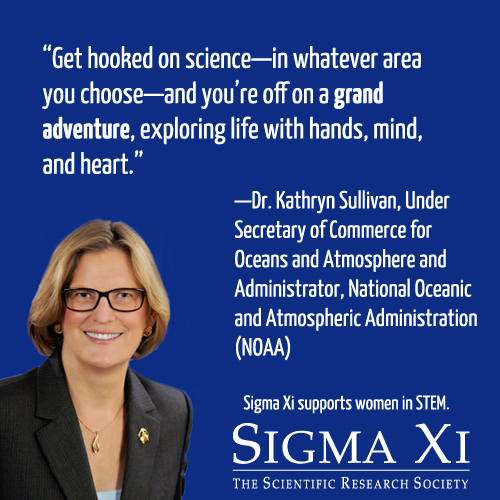
Year Elected to Sigma Xi:
1989
Current position:
Under Secretary of Commerce for Oceans and Atmosphere and Administrator, National Oceanic and Atmospheric Administration (NOAA).
Description of your job:
My job as head of NOAA is to put earth science to work so it helps people every day. NOAA turns data from satellites and cutting-edge science into understanding about our weather and climate, our oceans and coasts. Then we turn that into information that is helpful to farmers, airline managers, mayors, ship captains, and each of us. Millions of people use our information to keep their communities safe, businesses growing, and our economy strong. NOAA helps protect people from being hurt by dangerous weather, and helps keep our oceans healthy so the wondrous and very important life in the sea will thrive for generations to come. NOAA is a fantastic place to work. Our people are excited and passionate about what they do. At NOAA, people who have studied lots of different subjects and have many different talents can really thrive. Learn more on our Education site, http://www.oesd.noaa.gov/, and on our home page, NOAA.gov.
Please join us on social media!
Facebook: https://www.facebook.com/NOAA
Twitter: https://twitter.com/NOAA
Instagram: http://instagram.com/noaa
YouTube: https://www.youtube.com/noaa
Top Professional Accomplishments:
Dr. Sullivan is an accomplished oceanographer and the first American woman to walk in space. In 2004, she was inducted into the Astronaut Hall of Fame. Dr. Sullivan is a veteran of three shuttle missions, including the mission that deployed the Hubble Space Telescope. In 2014, TIME Magazine named her one of the “100 Most Influential People in the World." She received Sigma Xi's 2011 John P. McGovern Science and Society Award.
I love science because...
I’m really curious and I like adventure! I love the excitement of discovering new things and the creativity of figuring out how to tackle something completely new to me. I like to solve problems and puzzles, from the ones posed by rocks and minerals or critters to the ones posed by flying in space or going out to sea to do research. Science is like a non-stop adventure. But beyond that, I love science because it is indispensable to the quality of all of our lives. The deeper we dig, and the more we understand about our Earth, the greater success we will have in tackling fast-growing problems all around the world. Science is absolutely key to providing food, clean water, and energy for a rising population, and we definitely can’t tackle challenges of climate change without good science.
There is another significant reason that I value science. As someone who has run a business and worked with thousands of students of all ages, I know that science builds the skills businesses seek. Well-designed science learning experiences teach students how to observe, assess, and analyze. These skills equip students to deal with new problems and, often independently, figure out how to solve them. These are exactly the skills needed to keep America vibrant, innovative, and competitive.
Dr. Marye Anne Fox

Year Elected to Sigma Xi:
1998
Current position:
Teaches and conducts research as a distinguished professor of chemistry and biochemistry at University of California, San Diego.
First woman to be appointed Permanent Chancellor at University of California, San Diego.
Past Positions:
Chancellor of the University of California, San Diego, 2004-2012
President of Sigma Xi, The Scientific Research Society, 2001-2002
Scientific Accomplishments:
-
Accepted a 2009 National Medal of Science from President Barack Obama.
-
Led UC San Diego to a record in 2010 by surpassing $1 billion in research funding for the first time in the university’s history.
-
Received Sigma Xi’s 2012 John P. McGovern Science and Society Award. Also received Sigma Xi’s 1996 Monie A. Ferst Award for outstanding mentoring of graduate students.
Dr. Lise Abrams

Year Elected to Sigma Xi:
1991
Current position:
Professor and Chair of the Department of Psychology at the University of Florida.
Description of your job:
As a professor, my primary responsibilities include research and teaching. My research is in the domain of cognitive psychology, specifically memory and language and the changes in these processes that occur with normal aging. I teach both undergraduate and graduate courses in these topics, and I mentor doctoral students and undergraduates in research in my laboratory. As department chair, I have a range of administrative responsibilities and serve as the link between my department and the college-level administration.
Scientific Accomplishments:
With 32 journal articles and 13 book chapters, my recent publications have explored memory failures such as tip-of-the-tongue states as well as spelling errors that occur during writing. My research has been supported by the National Institute on Aging and the National Institute of Mental Health, and has been recognized by Sigma Xi, who awarded me the 2007 Young Investigator Award. I was also inducted into the University of Florida's Academy of Distinguished Teaching Scholars, which recognizes faculty who integrate superior teaching and research. I am a fellow of the American Psychological Association, the Gerontological Society of America, and the Psychonomic Society, and I am a member of the Association for Psychological Science and Women in Cognitive Science.
I love science because...
It presents me with an infinite list of problems to solve and challenges to overcome.
Amanpreet Kaur

Year Elected to Sigma Xi:
2013
Current position:
Graduate Student and Teaching Assistant, Department of Physics and Astronomy, Clemson University
Description of your job:
As a graduate student : I am working on obtaining my doctorate degree in physics from Clemson University. My area of research is astrophysics and I am studying the distribution of novae in our neighbor galaxy, Andromeda. A nova outburst is a nuclear explosion on the surface of a white dwarf which pulls matter from its companion star in a binary system, thereby increasing the brightness level by several thousand units.
As a teaching assistant : I teach astronomy labs based on solar system and stellar astronomy and utilize the planetarium in the department to explain some concepts in these classes.
Scientific Accomplishments:
• Awarded the best poster prize for “The first Ultraluminous X-Ray source (ULX) in M31'' at 'Time Domain Astrophysics with Swift' at Clemson University in October (24-26), 2011.
• Our collaboration with European Astrophysicists discovered the first Ultraluminous X-ray source in Andromeda galaxy in February, 2012. Read more here and here.
• Awarded research funding from Sigma Xi's Grants-in-Aid of Research Program twice :
1) for observing novae at 3.5m WIYN telescope, Kitt Peak, Arizona 2012.
2) for visiting the Max Planck Institute for Extraterrestrial Physics, Garching, Germany for a two-week training program, regarding the analysis training for data obtained from 2.2 m MPI\ESO telescope at La Silla, Chile (GROND instrument) for the photometric redshift determination of Blazars, in December 2013.
I love science because:
Science forms the basis of our understanding of existence. It explains our existence in this world. Being a student in the field of astrophysics, I have always been drawn to the mysteries of our Universe.
Dr. Tammy Maldonado

Year Elected to Sigma Xi:
2000
Current position:
Co-Director of STEM Education and Outreach at University of Colorado Boulder. President of the Sigma Xi University of Colorado Chapter.
Description of your job:
I teach and develop science curriculum for undergraduate courses and teacher professional development trainings. I work with research faculty to translate their research into hands-on, inquiry based lessons and labs and advise faculty on developing new CURE Courses (Course-based Undergraduate Research Experience).
I love science because:
Science nurtures one's natural instincts to wonder and allows us to take steps to answer our own questions. It encourages you to be curious, teaches you how to think, and provides the tools to search for answers.
Thoughts about being a woman in science:
Perseverance was my mantra. I was determined to succeed, I believed my research was important, and I surrounded myself with women scientists who also believed.
Dr. Shirley Ann Jackson

Year Elected to Sigma Xi:
1968, Life member
Current position:
President of Rensselaer Polytechnic Institute
Professor of Physics, Applied Physics, and Astronomy
Professor of Engineering Sciences
Description of your job:
As the president of a world-class technological research university, the first and oldest institution of its kind in the United States, I lead the development and implementation of the vision that allows Rensselaer Polytechnic Institute to bring together talented students and brilliant faculty to address our greatest global challenges.
Top career accomplishments:
Became the first African American woman to receive a doctorate from MIT in any field when I earned a PhD in theoretical elementary particle physics in 1973.
Conducted research at the Fermi National Accelerator Laboratory and AT&T Bell Laboratories. I was a visiting scientist from 1974-1975 at the European Organization for Nuclear Research (CERN).
Appointed by President Bill Clinton, with U.S. Senate confirmation, as chairman of the U.S. Nuclear Regulatory Commission from 1995-1999.
Served as president of the American Association for the Advancement of Science (AAAS). I've also been elected as a fellow of AAAS, the American Physical Society, and the American Academy of Arts and Sciences. I'm an international fellow of the Royal Academy of Engineering, UK. I also am a member of the U.S. National Academy of Engineering and the American Philosophical Society.
Served on the President's Council of Advisors on Science and Technology from 2009-2014.
Appointed by President Barack Obama as co-chair of the President’s Intelligence Advisory Board.
Named to the U.S. News STEM Leadership Hall of Fame.
I love science because:
Science allows us to work on the most fascinating of problems, while at the same time, elevating the human condition. It also teaches us about complexity and develops our ability to formulate important scientific questions, and to resolve them.
Thoughts about being a woman in science:
Confronted by great challenges, the world is in dire need of the talents of all scientifically-minded young people. Yet young women are not encouraged sufficiently to pursue scientific careers; sometimes they actively are discouraged. I would offer this advice to any young woman inspired by the possibility of discovery and innovation: Do not let others define who you are. Define yourself. Do not be limited by what others expect of you, but reach confidently for the stars.